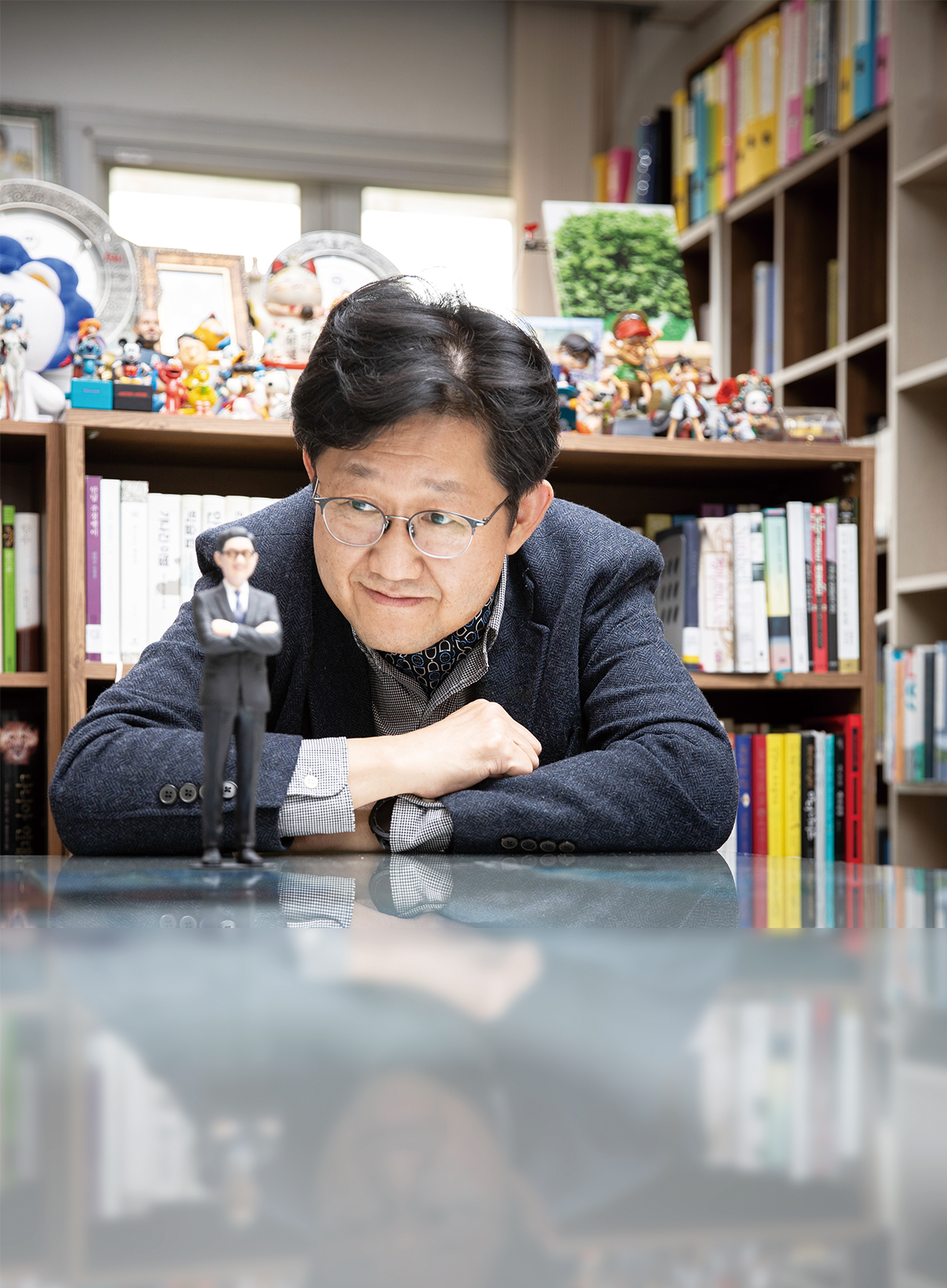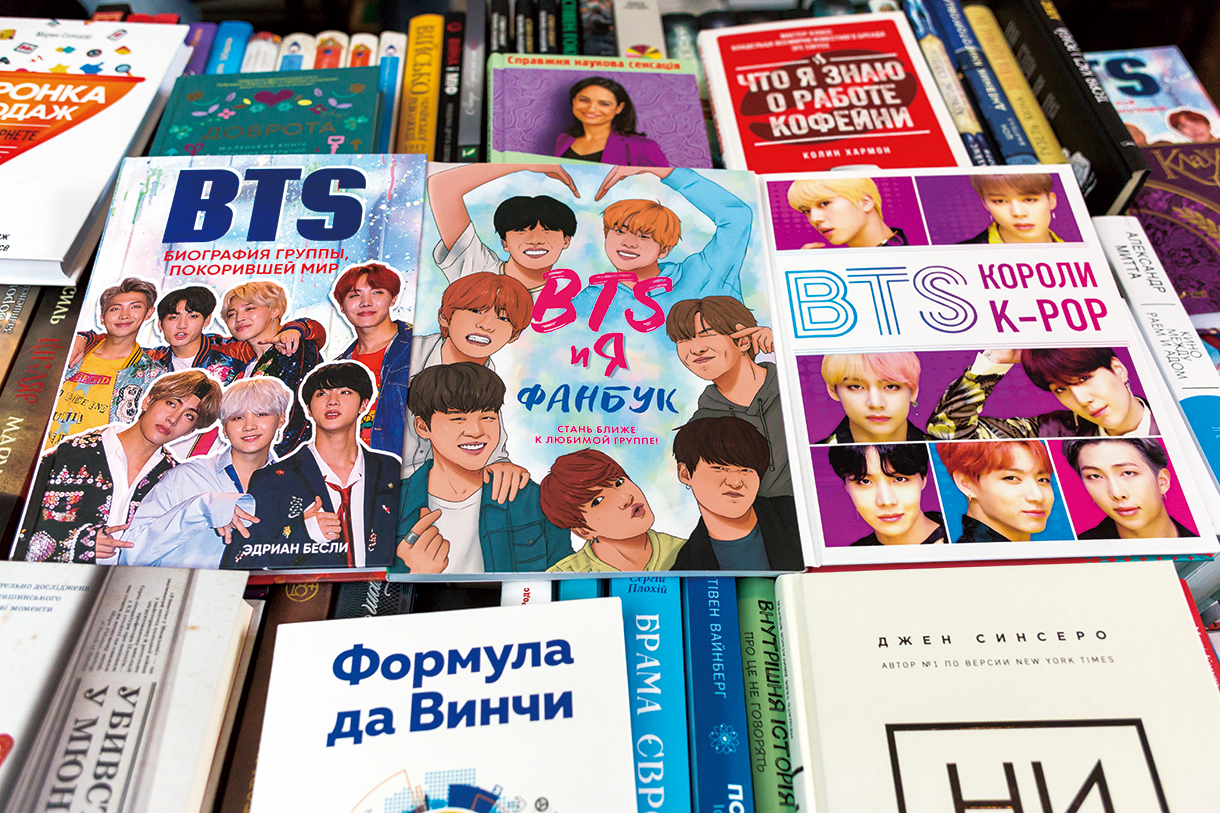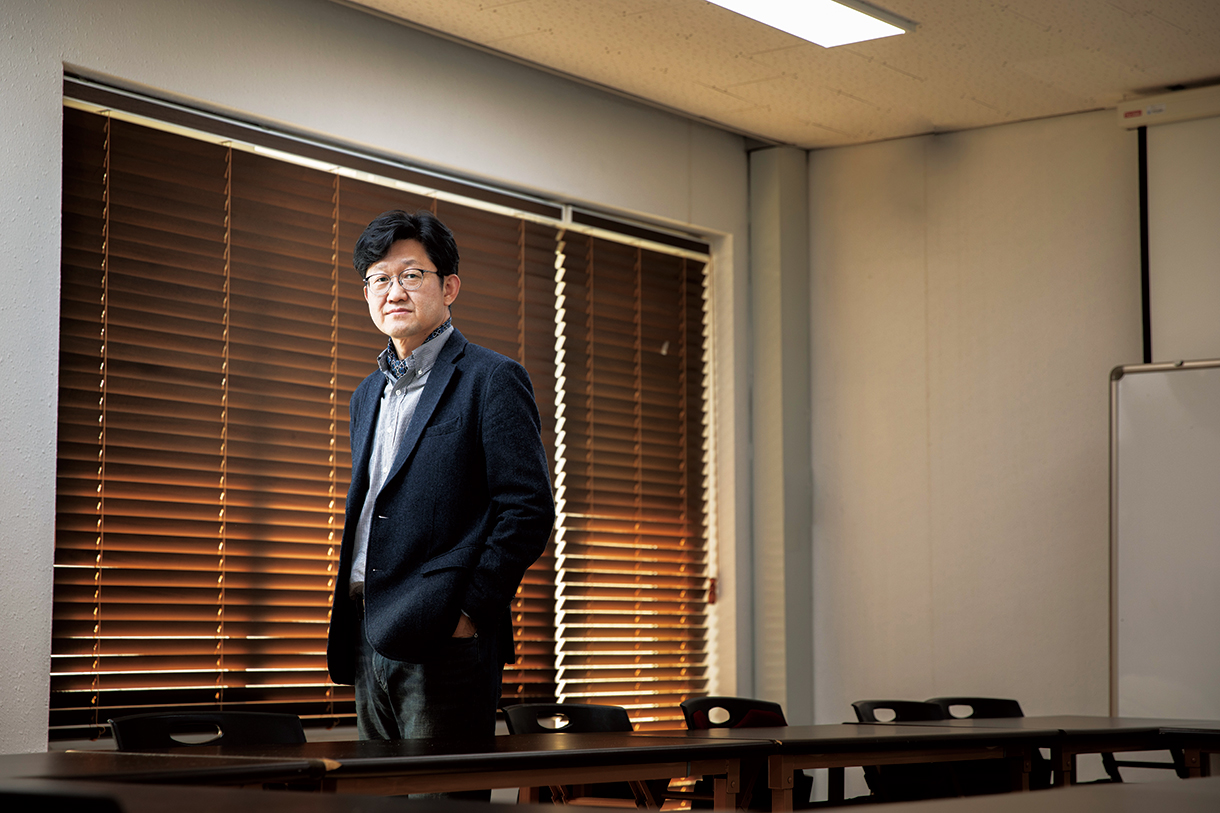

Story
다각화하는 한류,
진화하는 K-컬처의 미래는?
Diversified Korean Wave (Hallyu), What is the future of the evolving K-Culture?
ERICA캠퍼스 문화콘텐츠학과 박기수 교수
Professor Park Ki-soo, Department of Culture Contents, ERICA Campus
- 글 김현지
- 사진 손초원
- Writing Kim Hyun-ji
- Photograph Son Cho-won
Scroll Down
Various Korean cultural (K-Culture) contents has been loved from people all over the world. It is no longer a rarity to see foreigners watching Korean movies, dramas, and webtoons, enjoying Korean food and beauty products, and imitating Korean idol singers performing their dances and songs. The Korean Wave which is growing influence all over the world. Can we expect a continuation of the K-Culture, which is gradually expanding into other areas?

경제 · 산업 효과 이끄는 문화적 향기
다양한 분야에서 두각을 나타내는 한류는 경제 · 산업 효과 측면에서도그 영향력이 대단하다. 2020년 기준 한류 콘텐츠 매출액은 14조 원을 돌파한 것으로 파악됐다. 또 추산 방법에 따라 차이는 있겠으나 K-컬 처의 경제유발 효과는 30조 원에 이르는 것으로 추정된다. 물론 K-컬처는 단순히 경제적인 측면으로만 평가할 수 없다. 박기수 교수는 K-컬처가 국가 브랜드나 인지도 제고, 경제 · 산업에 미치는 간접적인 영향력 또한 크다고 설명했다.
“문화적인 파급 효과를 말할 때 ‘문화적 향기’라는 표현을 사용합니다. 향기가 퍼져나가듯, 문화의 영향력이 퍼지는 거죠. 핵심은 인식 제고에 있습니다. 어떤 특정 문화나 사람들에게 호감이 있으면, 그것과 관련된 상품이나 콘텐츠에 대한 호감도가 저절로 올라가는 것입니다. 이를테면, K-컬처의 영향력이 커질수록 우리나라 가전제품이나 자동차에 대한 호감도가 커져 구입으로 이어지는 겁니다.”
실례로 <사랑이 뭐길래>(MBC, 1991)가 1997년 중국 CCTV를 통해 방영되며 선풍적인 인기를 끌자, 중국 내에서 김치냉장고 판매량이 증가했다고 알려져 있다. 중국인이 김치를 주식으로 먹지 않는데도 불구하고 그만큼 드라마의 영향이 컸다는 것이다. <대장금>(MBC, 2003)은 현대자동차가 중국 시장에 정착하는 과정에 큰 영향을 미쳤고, 2003년 일본 NHK를 통해 방영된 <겨울연가>(KBS2, 2002)는 초대박 히트를 치며 일본 관광객 유치의 일등공신이 됐다. <별에서 온 그대>(SBS, 2013)가 큰 인기를 얻었을 때는 이른바 ‘천송이 효과’가 한국 패션과 뷰티 업계의 수출 호황으로 이어지기도 했다.
“문화와 호감은 흐름입니다. 아무리 좋은 것이라도 낯선 상태로 한 번에 성과를 낼 수는 없어요. 중동에서 <대장금>이 80%라는 기록적인 시청률을 얻었던 것 역시 문화적 향기가 쌓인 덕분입니다. 그 토대에는 문화와 사람이 있죠. 1970년대 중동으로 파견 간 수많은 한국 노동자가 보여준 ‘한국인의 근면 · 성실함’이 현지인들에게 호감과 신뢰를 쌓았고, 한국 가전제품이나 콘텐츠에 대한 호감으로 이어진 것입니다. 문화와 산업의 연관성을 보여주는 예는 많습니다.”
Cultural scent generating economic and industrial effects
The Korean Wave, which is growing in prominence in diverse fields has a great influence in terms of economic and industrial effects. As of 2020, sales of Korean Wave content are estimated to have surpassed KRW 14 trillion. Despite some disparity depending on the estimation method, the economic inducement effect of Korean culture (“K-Culture”) is estimated to reach KRW 30 trillion. It is true that the effect of K-Culture cannot be evaluated just from an economic aspect. Professor Park Ki-soo, Department of Culture Contents at ERICA campus, explains that K-Culture has a great indirect influence on the national brand image and recognition as well as on the economy and industry.
“When talking about cultural ripple effects, we often use the term ‘cultural scent,’ which means that just as scent spreads, so does the influence of culture. What matter is to raise people's awareness. If someone has good feelings for certain culture or people, they may automatically be likable to the product or contents related to it. For example, the greater the influence of K-Culture, the greater the preference for Korean home appliances and automobiles, leading to purchases,” he explained.
For example, after the Korean drama “Love, So What?” (MBC, 1991) was aired on CCTV in China in 1997 gaining sensational popularity, sales of Kimchi refrigerators reportedly increased in China. Even though Kimchi is not a main dish of Chinese people, the increase in sales of Kimchi refrigerators shows the huge influence of the drama. Another drama “Jewel in the Palace” (MBC, 2003) made a big contribution in the process of Hyundai Motor Company's entry into the Chinese market, and the drama “Winter Sonata” (KBS2, 2002), which was aired on NHK in Japan in 2003, was a big hit, significantly contributing to attracting Japanese tourists to Korea. When the drama “You who Came from the Stars” (SBS, 2013) gained great popularity, the so-called ‘Cheon Song-i effect’ led to a boom in Korean fashion and beauty exports.
“Culture and crush are a flow. No matter how good it is, it can’t make a hit if it is unfamiliar with people. The great success of “Jewel in the palace” in the Middle East, which gained a record audience rating of 80% was attributable to the time-honored cultural scent. The basis of cultural scent is culture and people. The numerous ‘hardworking and diligent Korean workers’ who were sent to the Middle East in the 1970s built up favorable and trustable relationships with locals, which led to a favorable impression of Korean home appliances and content. There are a lot of examples which show the connection between culture and the economy.”


종합적인 관점에서 K-컬처를 살펴볼 때
1990년대 후반부터 2000년대 중반까지를 한류1.0, 2000년대 중반부터 2010년대 초반까지를 한류2.0, 2010년대 초반 이후부터를 한류3.0이라 구분하기도 한다. 한류1.0은 드라마와 영화를 중심으로 한류가 태동한 시기다. 대부분 아시아권에서 누리는 인기였다. 한류2.0은 아이돌 스타와 음악을 중심으로 한류가 확산한 시기로 그 파급력이 아시아를 넘어 유럽이나 중동, 중남미에 미쳤다. 한류3.0에 이르러 한류는 더욱 다양화되며 전 세계로 퍼졌다.
“사실 ‘한류’라는 용어는 부정적인 의미에서 출발한 것입니다. 1999년 중국의 ‘북경청년보’라는 공산당 기관지에서 처음 등장했고, 한국 콘텐츠 인기에 대해 불편함과 분노, 약간의 공포를 담은 단어였어요. 1997년 IMF 사태 이후 21세기 먹거리를 찾던 우리 정부의 눈에 이 단어가 포착됐고, 정부가 담론을 생산하기 시작했죠.”
박기수 교수는 우리 정부가 문화콘텐츠 산업 성장을 위해 한류라는 표현을 전략적으로 사용했다고 설명했다. 그러면서 ‘한류’나 ‘K-’를 붙인 표현에는 반대하는 입장이라고 밝혔다. 문화는 보편성을 지녀야 하는 것으로 국가명을 붙이는 순간 장벽이 생길 수밖에 없다. 미국의 문화가 전 세계에 영향력을 발휘하고 있지만, 아무도 미국 문화를 ‘미류’라고 부르지 않는다. 한류를 강조할수록 ‘혐한류’라는 반발력에 밀릴 수 있음을 기억해야 한다는 지적이다.
영화 <기생충>(2019)이 국제 시상식을 휩쓸고, 웹드라마 <오징어 게임>(2021)은 신드롬급 화제를 낳았다. 방탄소년단(BTS)이 세기의 팝그룹 비틀스에 비견되고 여러 아이돌 스타들이 세계를 무대로 활약하고 있다. 한국어를 배우려는 수요도 급증했다. 전 세계적인 인기를 누리는 한류, K-컬처의 힘은 무엇일까? 박기수 교수는 K-컬처를 보다 종합적인 관점에서 파악해야 한다고 강조한다.
“먼저 한류가 무엇일지 생각해 봐야 합니다. 한국에서 한국인이 만든 콘텐츠만 한류에 해당할까요? 아니면 한국 자본이나 한국 전통문화가 들어가야 한류일까요? 이런 잣대로 판단한다면 아이돌 음악 중심의 K-팝이나 글로벌 자본과 손잡고 다양한 형태로 제작되는 K-드라마는 한류가 아닙니다. 한류의 핵심이 한국 문화 그 자체의 남다름이나 우월성에 있다는 주장은 위험해요. 시대의 특성과 비즈니스 환경 등을 종합적으로 고려해야 합니다.”
세계인이 K-컬처에 매력을 느끼는 것은 한 가지 이유가 아니다. △동서양의 문화, 전통과 현대가 역동적으로 융합된 국가 이미지 △고유한 역사와 문화가 가진 차별성 △조직적이고 체계적인 엔터테인먼트 산업 시스템 △인간에 대한 고찰을 담은 섬세하고 신선한 스토리텔링 △디지털 환경 고도화에 따른 미디어 환경 및 유통 채널 다양화 △여러 산업 분야에서 세계 수준의 기술력을 뽐내는 한국에 대한 선망 △민관 협력 등 다각적인 요인이 결합한 결과다.
“우리나라만큼 IT 기술과 디지털 시스템이 고도화되고, 새로운 것을 추구하며, 아이돌 문화가 주류를 이루는 나라가 없습니다. 문화의 중추가 되는 젊은 층이 선호할 수밖에 없죠. 코로나 팬데믹으로 오프라인 활동이 없어진 상태에서 세계의 10~20대 팬들은 온라인에서 K-팝을 향유했어요. 그리고 넷플릭스 등 글로벌 OTT의 영향력이 커지며 <오징어 게임>과 같은 콘텐츠가 엄청난 히트를 치게 된 것이죠.”
It’s time to look into K-Culture from a comprehensive perspective
There have been three generations of the Korean Wave: the first generation of the Korean Wave (Hallyu 1.0), late 1990s ~ mid-2000s; the second generation of the Korean Wave (Hallyu 2.0), mid-2000 ~ mid-2010s; the third generation of the Korean Wave, Hallyu 3.0, mid-2010s ~ present.
Hallyu 1.0 is the period when the Korean Wave started to draw attention centered on dramas and movies, mostly in the Asian region. Hallyu 2.0 was a period when the Korean Wave spread centered on idol stars and music, having its ripple effect beyond Asia to Europe, the Middle East, and Latin America. With Hallyu 3.0, popularity of Korean content became more diversified and spread all over the world.
“In fact, the term ‘Korean Wave’ had a negative meaning at first. In 1999, it was firstly coined by Beijing Youth Daily, a Communist Party journal, to depict discomfort, anger, and a little fear about the popularity of Korean content. Then, the Korean government, which was looking for a growth engine for the 21st century after the Asian financial crisis in 1997, seized upon the term ‘Korean Wave,’ and began to produce a discourse.”
Professor Park Ki-soo explained that the Korean government strategically used the term ‘Korean Wave’ to facilitate the growth of the cultural content industry. But, he opposes using the term ‘Korean Wave’ or a word starting with “K-”. Culture must be universal. If it is defined with a country’s name, barriers will inevitably be erected. Even though American culture is influencing all over the world, no one calls it “American Culture”. He pointed out that the more the Korean Wave is stressed, the more it can be pushed back by the anti-Korean Wave.
The movie “Parasite” (2019) swept international awards while the web-based drama “Squid Game” (2021) created a sensation like a syndrome. Korean boy band BTS is compared to The Beatles, the pop group of the century, and many idol stars are active on the global stage. The numbers of people seeking to learn the Korean language have also skyrocketed. What is the power of K-Culture? Why does the Korean Wave gaining such amazing global popularity? Professor Park Ki-soo pointed out that we must understand K-Culture from a more comprehensive perspective.
“First, we must think about what the Korean Wave means. Does only content created by Koreans in Korea fall under the Korean Wave? Or should Korean capital or Korean traditional culture be categorized as the Korean Wave? Under such standard, K-Pop centered on ‘idol’ music star or K-dramas produced in various forms financed by global capital cannot fall under the Korean Wave. It is dangerous to claim that uniqueness or superiority of Korean culture are the key to the Korean Wave. We must comprehensively consider the characteristics of the contemporary cultures and the business environment.”
There is more than one reason for people around the world to be attracted to K-Culture. Popularity of K-Culture is the result of combination of multiple factors; national image with a dynamic convergence of Eastern and Western culture, as well as tradition and modernity; particularity with unique history and culture; an organized and systematic entertainment industry system; delicate and fresh storyline reflecting contemplation on human beings; media environment and diversified distribution channel in line with the advanced digital environment; admiration for Korea’s world-class technological prowess recognized in various industries; and public-private cooperation.
“There is no country other than Korea where IT technology and digital systems are advanced, new things are being pursued, and idol culture becomes the mainstream. It is natural for young people, who are leading the consumption of culture, to be fascinated by Korean content. When offline activities were restricted due to the COVID-19 pandemic, people in their teens and twenties around the world enjoyed K-pop online. And as the influence of global OTTs such as Netflix grew, content like Squid Game became a huge hit.”

K-컬처의 미래, 지속가능한 가치 투영에 달렸다
한류는 점점 다각화, 고도화되며 성장의 발판을 확장하고 있다. 눈에 띄는 것은 IP(Intellectual Property, 지식재산권) 분야다. 우리나라 대표 포털사인 네이버는 이미 세계 1위 웹툰 플랫폼을 보유한 가운데 2021년 할리우드 히트 영화들의 원작 소설이 탄생했다는 웹소설 플랫폼 왓패드(Wattpad)를 6500억 원에 인수했다. 이로써 네이버는 콘텐츠 제작의 시발점으로 웹툰과 웹소설을 포지셔닝했고, 동시에 이를 통한 빅데이터를 확보함으로써 거점 콘텐츠 제작에 있어 신뢰할 만한 리스크 헤지(risk hedge)의 토대를 마련하게 됐다. 콘텐츠 기획부터 창작, 유통, 확장에 이르기까지 수직적으로 계열화함으로써 트랜스미디어스토리텔링을 주도적으로 추진하게 된 것이다. 네이버가 미국에 론칭한 웹툰 플랫폼 ‘Webtoon’에는 DC코믹스의 작품들까지 연재되고 있는데, 이것만으로도 우리나라 IP 산업의 위상을 충분히 보여준 사례로 평가할 수 있다.
“만화를 가리키는 용어는 ‘웹코믹’이고 웹툰은 말도 안 되는 콩글리시에요. 하지만 한국의 만화 콘텐츠와 플랫폼이 세계로 퍼지며 웹툰이라는 단어가 일반적으로 통용되고 있죠. 최근에는 웹툰과 웹소설을 기반으로 책 출판과 드라마, 영화, 게임 제작이 전방위적으로 이뤄지는 추세입니다. 이런 점에서 볼 때 한류는 계속 발전할 수 있는 원동력을 확보한 셈이죠.”
박기수 교수는 최근 36명의 전문가와 함께 국내 스토리텔링 이론 구축과 성과를 집대성한 <K-스토리텔링>을 공동 집필해 출간했다. 책에서는 스토리텔링에 대한 다양하고 역동적인 접근이 한국 스토리텔링의 힘이라고 논하고 있다. 박기수 교수는 콘텐츠 무한경쟁에서 살아남기 위해서는 눈앞의 이익이 아니라 지속가능성에 초점을 맞춰야 한다고 조언했다.
“현재 K-컬처의 대부분은 상품으로 소비되고 있습니다. 그런데 상품만 있고 진짜 문화가 휘발되면 지금까지 쌓아온 기반과 인기가 한순간에 붕괴할 겁니다. 상품은 언제든지 더 좋은 상품으로 대체될 수 있으니까요. 따라서 K-컬처 콘텐츠의 퀄리티를 높이고 삶을 조금 더 풍요롭게 하는, 긍정 메시지를 주는 가치를 담아야 합니다. 또 일방적으로 한류를 공급하는 것이 아니라 세계인과 문화를 교류하고자 노력해야 합니다.”
글로벌 OTT 시대, IP 중심 콘텐츠 시대는 K-컬처의 기회이자 위기가 될 것이다. 우리의 역량과 강점을 어떻게 극대화할 것인지 고민하고, 문화적 향기를 통해 K-컬처의 지속가능성을 확보해야 할 때다.
The future of K-Culture depends on the reflection of sustainable value
The Korean Wave has been gradually diversified and advanced, expanding its bases for growth. The field of Intellectual Property (IP) is the most prominent. “Naver,” Korea’s No.1 search portal, has already been equipped with the world’s No. 1 webtoon platform. In 2021, it acquired ‘Wattpad,’ a web novel platform that is reported to have created original novels for Hollywood hit movies, for KRW 650 billion. Naver has positioned itself as a webtoon and web novel platform as the starting point to enhance its capacity to produce contents, and at the same time, it secured big data through them, ensuring reliable risk hedge in the production of positioned content. Naver has finished its preparation for facilitating transmedia storytelling by vertically systemizing contents industry from content planning, creation, distribution, and expansion. ‘Webtoon,’ a webtoon platform launched by Naver in the United States, has published even DC Comics’ works, which can be evaluated as an example that sufficiently demonstrated the power of Korea’s IP industry.
“‘Webcomic’ is the right term for comics published on the online platform and ‘webtoon’ is a ridiculous loan word adapted by Korea (a.k.a. Konglish). However, as distribution of Korean comic contents and platforms worldwide increases, the word ‘webtoon’ is now being more generally used. Recently, book publishing as well as drama, movies, and game production are being produced in all sectors based on webtoons and web novels. In this regard, the Korean Wave has secured the driving force for sustainable development.”
Recently, Professor Park Ki-soo and 36 other experts co-authored and published K-Storytelling, a compilation of Korean storytelling theories and achievements. In the book, he argues that a diverse and dynamic approach to storytelling is the power of Korean storytelling.
Professor Park advised that we must focus on sustainability, rather than short-sighted profits to win over other countries in the infinite competition for content, explaining:
“Currently, most K-Culture consumption centers on the products. However, if it fails to reflect true culture except for products, the foundation and popularity which have been built so far will collapse in an instant. A product can be replaced with better products at any time. Therefore, we must upgrade the quality of K-Culture content and deliver values that give positive messages that enrich people’s lives. In addition, we must strive to exchange cultures with people around the world, rather than simply supplying K-Culture via the Korean Wave unilaterally.”
The era of global OTT and the era of IP-centered content will be both an opportunity and a challenge for K-Culture. It is time to consider how to maximize our capabilities and strengths, and to secure the sustainability of K-Culture through cultural scents.
글로벌 OTT 시대, IP 중심 콘텐츠 시대는 K-컬처의 기회이자 위기가 될 것이다.
지속가능성을 고민해야 할 때다
The era of global OTT and the era of IP-centered content will offer both an opportunity and challenge for K-Culture. It is therefore time to consider the sustainability.

